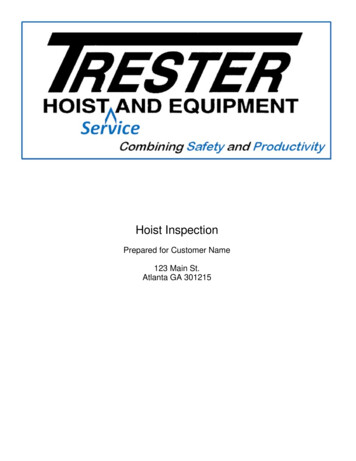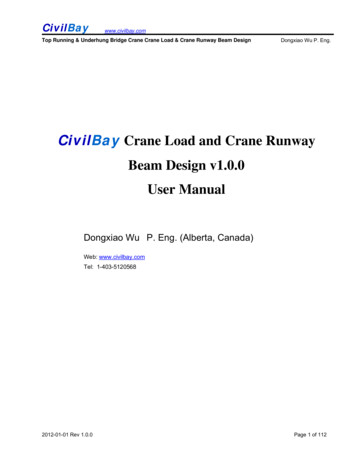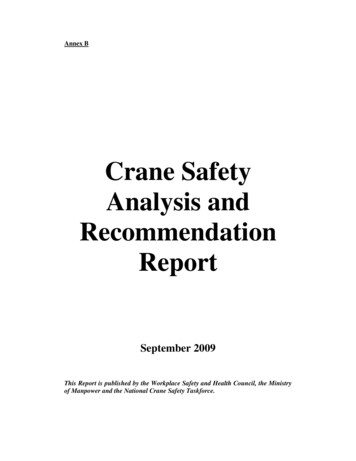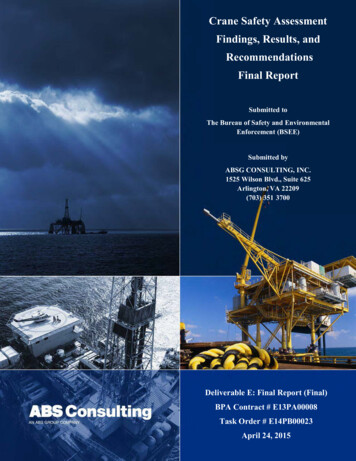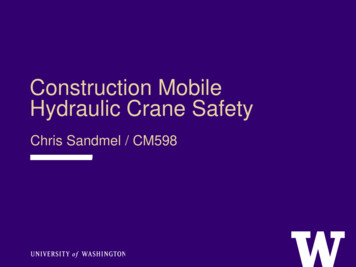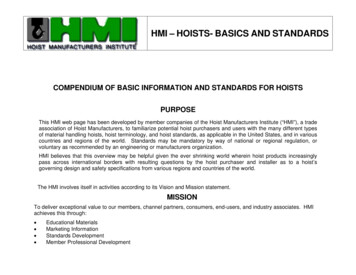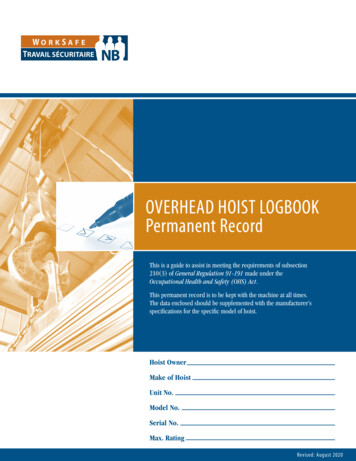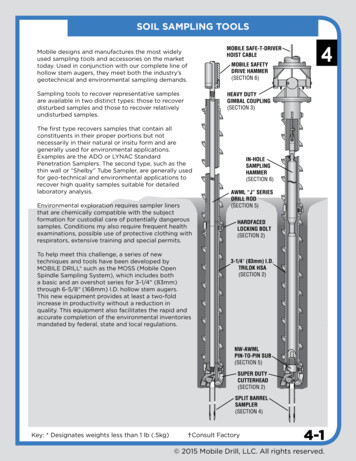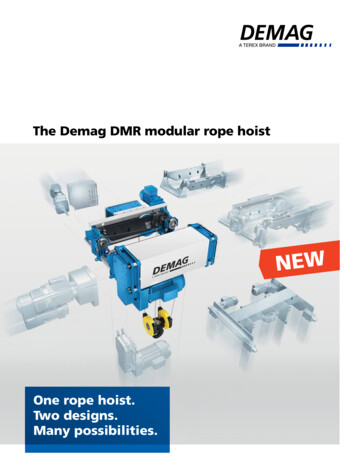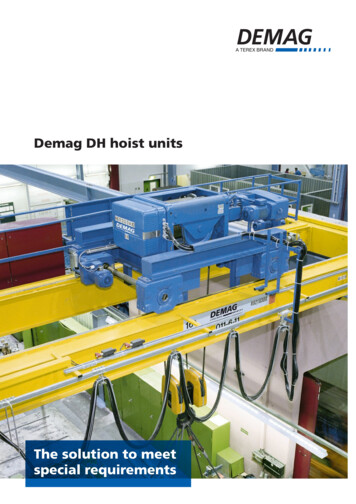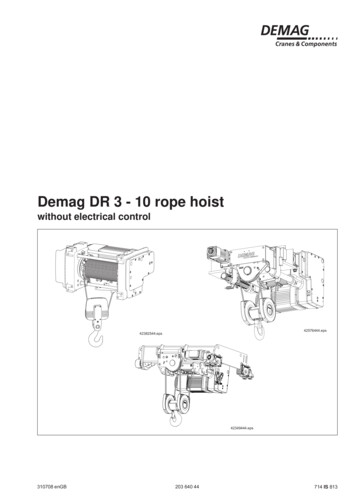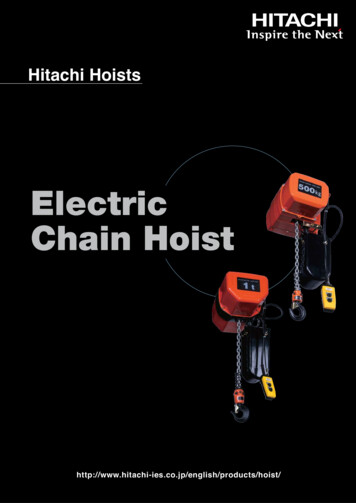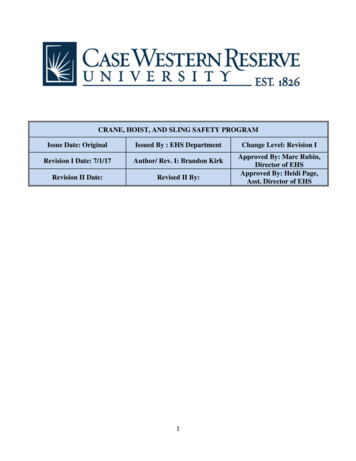
Transcription
CRANE, HOIST, AND SLING SAFETY PROGRAMIssue Date: OriginalIssued By : EHS DepartmentRevision I Date: 7/1/17Author/ Rev. I: Brandon KirkRevision II Date:Revised II By:1Change Level: Revision IApproved By: Marc Rubin,Director of EHSApproved By: Heidi Page,Asst. Director of EHS
Objective Cranes, hoists and slings pose a serious safety hazard, such as breaking, becomingunbalanced or falling due to excessive weight, if not used properly. It is the policyof Case Western Reserve University (CWRU) to ensure employees are trained onthe hazards of using cranes, hoists and slings and also to make certain that suchequipment is safely maintained. 29 CFR 1910.179 (Overhead and Gantry Cranes);29 CFR 1910.184 (Slings); ASME B30.21 (Manually Lever Operated Hoists);ASME B30.11 (Monorails and Under-hung Cranes); ASME B30.16 (OverheadHoists); ASME B30.17 (Overhead and Gantry Cranes); ASME B30.10 (Hooks);ASME30.20 (Below-the-Hook Lifting Devices); ASME B30.26 (RiggingHardware)The Crane, Hoist and Sling Safety Program’s purpose is to guarantee the safe useof cranes, hoists and slings, ensure that work units understand and comply withsafety standards related to cranes, hoists and slings and assign responsibilities topersonnel who are necessary for the successful implementation of this program.This program applies to all employees at CWRU who work with or supervisethose who handle cranes, hoists and slings.2
Table of ContentsDefinitions. .4Responsibilities .6Budget Executives and Budget Administrators .6Department of Environmental Health and Safety (EHS) 6Supervisors ǀ Faculty ǀ Lab Managers ǀ PI’s 6Employees .7General Requirements for Cranes, Hoists and Slings .7Training .8Inspections for Cranes, Hoists and Slings .9Pre-Use Inspection . .9Daily Inspections .9Monthly Inspections 9Annual Inspections 10Maintenance .10Recordkeeping . .10Contractors .11Appendix A .12Appendix A Pre-Use Crane, Hoist and Sling Inspection Guidelines.13Appendix B .14Appendix C .16Appendix D .19Appendix E .20Appendix F .21Appendix G .243
1.0Definitions-Authorized person (repair): Someone with training and experiencepertaining to crane and hoist repair. There are specific considerations thatare unique to cranes and hoists, thus the person must have training andexperience in crane and hoist repair.-Bridge: indicates that part of a crane consisting of girders, trucks, end ties,foot walks, and drive mechanism which carries the trolley or trolleys.-Bridge crane: A load lifting system consisting of a hoist which moveslaterally on a beam, girder or bridge which in turn moves longitudinally ona runway made of beams and rails. Loads can be moved to any pointwithin a rectangle formed by the bridge span and runway length.-Bumper: A device for reducing impact when a moving crane or trolleyreaches the end of its permitted travel, or when two moving cranes ortrolleys come in contact with each other. This device may be attached tothe bridge, trolley or runway stop.-Competent trainer: An employee who has demonstrated familiarity withthe type of crane/hoist in their work unit; a contractor or equipment vendorwho has experience or training in crane/hoist operation and is familiarwith the equipment.-Competent evaluator: An employee in the department/work unit who isexperienced and competent with the crane. An employee must be familiarwith the equipment and its safe operation. In order to be consideredcompetent in regard to conducting the evaluation portion of the cranetraining, an employee must have successfully completed the classroomportion of crane/hoist training. This employee could be, but is not limitedto, a certified operator, supervisor/manager or safety officer.-Crane: A machine for lifting and lowering a load and moving it horizontallywith the hoisting mechanism acting as an integral part of the machine. Cranes canbe driven manually or by power.-Drum: The cylindrical member around which rope is wound for lifting orlowering the load.-Designated person (monthly inspections): A selected individual who has beenassigned by the employer or the employer’s representative as being qualified toperform specific duties.-End truck: An assembly consisting of the frame and wheels which support thecrane girder(s) and allow movement along the runway.4
-Floor operated crane: A crane controlled by an operator on the floor or anindependent platform using a pendant or non-conductive rope.-Gantry crane: A crane that has a hoist in a trolley which runs horizontallyalong gantry rails, usually fitted underneath a beam spanning betweenuprights. The uprights have wheels so that the whole crane can move atright angles to the direction of the gantry rails.-Hoist: A suspended machinery unit that is used for lifting or lowering afreely suspended (unguided) load.-Limit device: A device that is operated by some part or motion of a powerdriven hoist to limit motion.-Monorail: A trolley suspension crane hoist whose trolley is suspendedfrom a single rail. This type of crane hoist is used to move a loadhorizontally.-Overhead crane: A crane with a movable bridge carrying a movable orfixed hoisting mechanism and traveling on an overhead fixed runwaystructure.-Reeving: A system in which a rope or chain travels around drums, sheavesor sprockets.-Rope: Refers to wire rope unless otherwise specified.-Sheave: A grooved wheel or pulley used with a rope or chain to changedirection and the point of application of a pulling force.-Trolley: The unit which travels on the bridge rails and carries the hoistingmechanism.-Wall mounted jib crane: A crane with a jib and with or without a trolley.The wall crane is supported from a side wall or columns of a building.5
2.0Responsibilities Budget executives and budget administrators Ensure that responsibilities assigned within this program arecarried out within their administrative work unit. Designate individuals within each work unit who will beresponsible for the implementation of this program. Actively support this program as part of the work unit’s overallsafety effort. Ensure adequate funding is available to reinforce this program.Department of Environmental Health and Safety (EHS) Assist work units in implementing the provisions of this program Periodically, review and update this written program. Periodically, evaluate the overall effectiveness of this program. Determine the applicability of this program to activities conductedwithin their work unit. Coordinate the implementation of this program within their workunit. Be knowledgeable of components of this program and ensure itscompliance. Assist in the investigation of serious accidents related to cranes,etc. Actively support this program as part of the work unit’s overallsafety effort.Supervisors ǀ Faculty ǀ Lab Managers ǀ PI’s Be thoroughly informed of the contents of this program and itsapplication to their areas of responsibility and authority. Ensure employees comply with all provisions of this program.6
3.0 Ensure employees receive training appropriate to their assignedtasks and maintain documentation of such training. Ensure employees are provided with and use appropriate protectiveequipment. Take prompt corrective action when unsafe conditions or practicesare observed. Investigate injuries and incidents within various work units relatedto crane, hoist and sling usage.Employees Follow the work practices described in this program, including theuse of appropriate protective equipment. Attend all training required by this program. Immediately report any unsafe conditions or concerns related tocranes, hoists or slings to their supervisor.General Requirements for Cranes, Hoists and Slings The work unit must notify EHS when a crane or hoist is installed. This isrequired so that EHS can add the unit to annual inspection schedule. Only trained employees shall operate a crane or hoist. If the need arises tooperate crane or hoists not owned by CWRU, contact EHS for furtherguidance. Cranes and hoists shall go through a pre-use annual inspection. Slings shall go through pre-use and annual inspections. Any unsafe condition noted during an inspection shall be corrected beforethe equipment is used. Operators shall comply with the manufacturer’s specifications andlimitations applicable to the operation of the equipment. When manufacturer’s specifications are not available, the limitationsassigned to the equipment shall be based on the determinations of aqualified engineer competent in this field and such determinations will beappropriately documented and recorded.7
4.0Operators shall follow safe work practices when operating cranes, hoistsand slings. (Refer to Appendix F.)Training Training must be completed prior to any use of a crane or hoist. Trainingof crane and hoist operators at CWRU is a two-step process for themajority of cranes/hoists which consists of classroom instruction andhands-on training. A documented operator evaluation is required for operator of bridgecranes. (Refer to Appendix G.) Classroom instruction, hands-on training and operator evaluations can beconducted by either a competent trainer in the work unit, the equipmentmanager, a safety consultant and/or a vendor who specializes incrane/hoist training. Hands-on training and hands-on evaluation portions of the training canalso be conducted by an employee in the department/work unit who isexperienced and competent with the equipment. This person could be atrained operator, supervisor/manager or safety officer. Training must be specific to the type of equipment being used. Training shall include the following: Characteristics of safe crane and hoist operation Inspection procedures Basic load handling considerations Operator responsibilities Communication used during crane and hoist operation Hands-on equipment training Trainees must successfully complete hands-on training before beingallowed to operate the equipment independently. Trainees will be givenadequate supervision and time to learn basic operating skills. Refresher training in relevant topics will be provided to a crane or hoist operatorwhen any of the following occur:8
5.0 The operator has been observed to be using the equipment in anunsafe manner The operator has been involved in an accident or a near missincident The operator is assigned to operate a different type of equipment A condition in the workplace changes in a manner that could affectthe safe operation of the equipmentInspections for Cranes, Hoists and Slings Pre-Use Inspection (Refer to Appendix A.) Prior to use, the operator shall visually inspect the crane, hoistand/or slings for defects. The pre-use inspection will identify conditions that could affect thesafe use of the equipment. Operators must immediately report any unsafe crane conditions totheir supervisor or lab manager. The supervisor is then responsiblefor ensuring the necessary arrangements are made for repair. Only authorized personnel shall perform repairs and adjustments. All replacement parts shall be the same design as the original or anequivalent design as designated by the manufacturer.Daily Inspections Daily inspections are to be supplemented with monthly and annualinspections.Monthly Inspections Monthly inspections can be conducted by qualified personsdesignated by the department. Monthly inspections should bedocumented. They should include all items described for the dailyinspections, as well as the following:-Deformed, cracked or corroded members and braces ormissing fasteners-Cracked or worn sheaves, drums, sprockets, clamping9
devices, bumpers, etc. Annual Inspections 6.0Maintenance 7.0Inspections are conducted by a qualified outside contractor.CWRU’s current contract can be found in the Crane inspectionbinder on file with the facilities safety manager at EHS. Thefacility safety manager is responsible for coordinating theinspections.Preventive maintenance shall be performed as prescribed by themanufacturer as detailed in the owner’s manual.Recordkeeping Each department is responsible for maintaining the following records inorder to meet the requirements of this program: A listing of all cranes and hoists A record of training which includes: (Refer to Appendix E orequivalent)-Name of trainer-Name of operator-Date of training (classroom, hands-on training and handson evaluation) Copies of all monthly inspection records for one year aftercompletion Copies of annual inspection records for at least four years Copies of repair records for the life of the equipment Copies of load test results for the life of the equipmentEHS is responsible for maintaining the following records in order to meetthe requirements of this program:10
8.0EHS will retain training records for training they have providedindefinitelyContractors Contractors are required to follow all applicable OSHA regulations andmanufacturer’s instructions. Contractors are not permitted to use anycrane, hoist or sling owned by CWRU.11
Appendix APre-Use Crane, Hoist and Sling Inspection GuidelinesItem (Cranes and Hoists)Load rating marked on each side of the craneLoad rating of the hoist marked on the hoist or its load block andlegible from the ground? (If the crane has more than one hoistingunit, each hoist shall have its rated load marked on
Hoists); ASME B30.17 (Overhead and Gantry Cranes); ASME B30.10 (Hooks); ASME30.20 (Below-the-Hook Lifting Devices); ASME B30.26 (Rigging Hardware) The Crane, Hoist and Sling Safety Program’s purpose is to guarantee the safe use of cranes, hoists and slings, ensure that work units understand and comply with safety standards related to cranes, hoists and slings and assign
